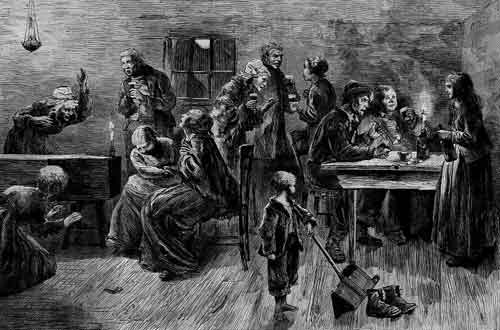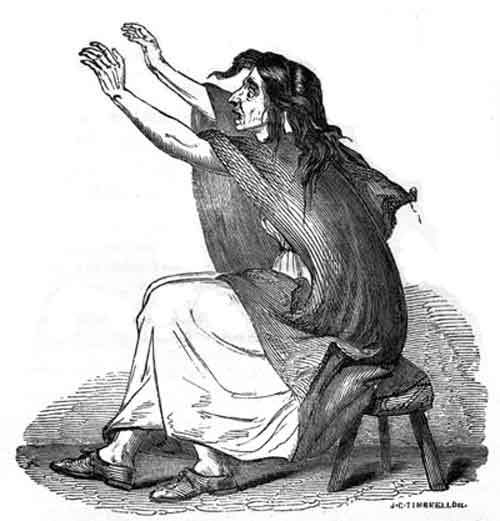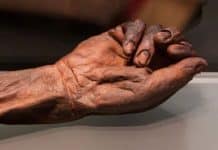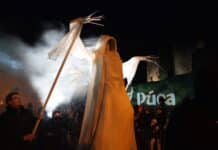The Irish have some long-held beliefs and practices when it comes to honouring their dead. ANN MASSEY checks out these Irish Funeral traditions

Irish Funeral Traditions
The Irish are known for their religious beliefs, superstitions and celebration of life and these traits are reflected in death. Every care is taken to ensure a smooth journey for loved ones into heaven and to keep the Gates of Hell firmly shut.
The Sin Eater in Ireland
Sin Eating may be known to various cultures, however, in Ireland it was practiced up until the late 19th century.
Sin Eaters were called upon by households that had suffered bereavement in an effort to avoid damnation and save the souls of the dearly departed.
Considered to be the lowest of professions, the task usually fell to a disgraced priest ex-communicated from the Church, who would travel from village to village visiting the homes of the deceased, charging for his services.
Instead of absolving the dead from their transgressions, he would take food and drink as part of a spiritual cleansing ritual in which blood would pass onto the food and he would effectively ‘eat’ the sins, allowing the soul of the dead to pass into Heaven and rest in peace.
When a Sin Eater died, however, he would enter into the pits of Hell, carrying the weight of all those sins he had ingested for eternity.
Keening for the Dead in Ireland

Many families in Ireland for generations have had their own Banshee (Bean Sidhe) tied to their mortality who lets out a blood curdling scream when death in the house is imminent.
Not to be outdone, families without such an entity would hire a professional Keener (from the Irish ‘Caoineadh, meaning to cry) to do the job instead.
These were not random wails from mourners, but controlled high-pitched lamentations from trained women who would seek payment in food and drink.
The Keeners would attend the wake to perform and not a moment sooner.
In the event keening began before the dead had been laid out, evil spirits would be invoked and the Hounds of Hell were believed to be sent to collect the soul of the departed and take it back to eternal torment.
Waking in Ireland
Being Ireland, there has always been a fondness for a drop of Guinness.
Legend has it that waking began as this tasty beverage was supped from pewter tankards and the side effect was lead poisoning.
This caused the consumer to take on the appearance of being dead, when in fact they were in a catatonic state.
Family and friends would therefore stand vigil to see if they would wake so as to avoid the horror of being buried alive.
The tankard story is believed to be a myth and the truth is that Waking has been a Celtic tradition for centuries as a way to honour the departed, however, in times gone by this would also include watching to see if the dead would rise again.
Even to this day, the deceased is laid out in their finest clothes, traditionally in the parlour of their home and loved ones gather for prayers and respects, keeping the dead company until they are buried.
Household Irish Funeral Rituals
Every household would have its own rituals and traditions on the passing of a loved one and many still do.
Most common, however, was the opening of the bedroom window to allow the spirit of the departed to escape the confines of their body and home and pass on to the next realm.
No one was to stand between the dead and the window as this would block the path to eternal rest and anyone who did so would be cursed for ever more.
Mirrors would be covered or turned to the wall so the soul would not become trapped within.
Clocks would be stopped at the time of death to prevent bad luck and as a mark of respect, because if a clock in the house was to stop of its own accord, another imminent death in the family would occur.
Burials in Ireland
As the departed left for their final journey, where and how they were buried was not as straightforward as it seems.
In the Stone Age, the position you were buried in depended entirely on your status. You could be lying down, sitting, or if a great warrior, standing up for eternity.
In the Bronze Age beliefs changed and fire was deemed the only way to destroy the body and release the soul to the spirit realm.
In the Middle Ages, if it was thought that you would return from the dead and devour the living, you would be buried in un-consecrated ground, bones broken and weighed down.
Up until very recently, infants who passed on without baptism or those who took their own lives would not be entitled to the rituals of waking, blessing and consecrated burial and would be buried, often in the still of night outside of the cemetery walls or in unmarked graves.
Of course these days’ Irish funerals and wakes are celebrations of life and much of the superstition is gone, however, I for one wouldn’t stand by an open window or want to be around if the clock stops!
Did we miss any Irish Funeral Traditions that you know about? Tell us about them in the comments section below!
Discover 5 Strange British Funeral Superstitions here!








Ann O’Regan, my great grandfather died on October 31, 1925 here in upstate New York. His father came from Ireland in 1838, and the family maintained many Irish beliefs and customs. They marked his tombstone October 30, and family lore says they changed the date as it was not a good thing to die on Halloween. Is this something you have heard? Thank you for your time.